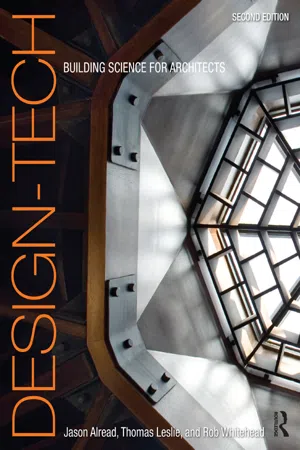Technology & Engineering
Two Force and Three Force Members
Two force and three force members are concepts used in engineering to analyze the forces acting on a structure. A two force member is a structural component subjected to only two forces, while a three force member is subjected to three forces. Understanding these concepts is important for designing and analyzing the stability and strength of structures.
Written by Perlego with AI-assistance
Related key terms
Related key terms
1 of 4
Related key terms
1 of 3
4 Key excerpts on "Two Force and Three Force Members"
- eBook - ePub
- Tianjian Ji(Author)
- 2020(Publication Date)
- CRC Press(Publisher)
0.414 in Frame B. This indicates that Frame B has a more uniform distribution of the internal forces than Frame A (Structural concept 3).It can be observed from this example that the first three structural concepts are exchangeable. Although any of the three structural concepts can be used for the design of the bracing patterns, for this particular example achieving a more direct internal force path is easier than creating smaller internal forces or a more uniform distribution of internal forces. In other cases, using the second or third structural concepts may be more convenient than using the first structural concept. This understanding is useful for design as different approaches can be followed to achieve smaller deflections.2.7.4 Compatibility
The first three structural concepts may not be fully compatible as they are stated from different perspectives based on the same equations. A more direct internal force path requires that more members are in a zero-force state which may lead to larger internal forces in the other members. On the other hand, the more uniform distribution of internal forces may imply that more members share internal forces so that there are no large differences between the internal forces in individual members. This type of incompatibility can also be demonstrated using an example.Two similar 3-bay and 4-storey truss type structures with the same dimensions are shown in Figure 2.7 . The horizontal and vertical members have the same length of L and all members have the same material property E and cross-sectional area A. Each frame has 32 members including 4 bracing members. The only difference between the two frames is the arrangement of the bracing members in the bottom left panels.- Frame A
- eBook - ePub
Basic Engineering Mechanics Explained, Volume 1
Principles and Static Forces
- Gregory Pastoll, Gregory Pastoll(Authors)
- 2019(Publication Date)
- Gregory Pastoll(Publisher)
When we dealt with forces in one plane only, we had enough information to determine the relative magnitudes of the rectangular components of each force. Any force F had two components:Fx = F cos θ; Fy = F sin θand the direction of the force F was defined by one angle, θ, specified relative to the x-axis.However, when working in three dimensions, each force has three components: Fx , Fy and Fz . The direction of a force cannot be defined by one angle alone, but has to be defined by three angles.This can make solutions that rely on calculations very complicated. Also, when working with a 3-D structure, it is virtually impossible to conceive of a graphical solution that can be done on paper, because working in the plane of the paper is restricted to 2-D. However, there is a method that simplifies calculations by dispensing with the need to specify angles.This method, called the proportional technique, was developed by the present author, and relies on the fact that the tension in a tie has to lie in the same direction as the tie, just as the compressive force in a strut must lie in the direction of the strut. This is exactly the same observation that was made by Maxwell, though now applied in three dimensions.The method is based on there being a unique constant of proportionality between the magnitude of each individual force and the length of the member carrying that force. The constant of proportionality for a given member allows us to solve for the force in that member. We can determine the unique constant of proportionality for any one member, if the displacements of the remote end of that member are known.An example in 2-D will serve to illustrate the proportional relationship between the direction of the force in a tie and the direction of the tie:Consider a force F applied at point o by a rope oa . Here are shown the force and its rectangular components superimposed on a diagram showing the displacement of point a from point o - eBook - ePub
Design-Tech
Building Science for Architects
- Thomas Leslie, Robert Whitehead(Authors)
- 2014(Publication Date)
- Routledge(Publisher)
qualities, but they represent important three-dimensional behaviors for how forces flow through a structural system. The manner is which forces work their way through a system is inextricably linked with its manner of construction and arrangement of components. Even though structures are interconnected, engineers often divide up the design of the system into a series of smaller elements that can be solved in relation to each other. This finite element analysis approach allows engineers to design each component in the system based upon the anticipated loads. In order to achieve this analysis, loading conditions throughout the structure need to be established and quantified. Next, one has to know the length of each component's span and its frequency of spacing in order to find the tributary area for what is being supported by each component. This information is then represented two-dimensionally (using the types of loading examples shown above) to solve for support conditions and internal forces within each component to create a state of equilibrium. Even though buildings are supported from the ground up, analyzing the way forces move through the system starts at the top and works its way downward. Typically loads are transferred from the smallest members that are spanning modest distances, such as the roof/floor decking that spans between joists, to the progressively larger, stronger, set of components, such as the beams that carry the joists and span between columns. Forces are transferred, consolidated and accumulated throughout the structure until their eventual transfer into the foundation. Note that in the Figure 20.9, examples of both distributed and concentrated loads are shown. Interestingly, even though the joists that hold up the roof are acting as concentrated loads upon the beam below, they essentially are imparting an equally distributed load along the length of the beam - eBook - ePub
- Bryan J.B. Gauld(Author)
- 2014(Publication Date)
- Routledge(Publisher)
However, as has been mentioned above, the reduction in the weight is achieved at the expense of the span to depth ratio. If the depth is critical, then a compromise between a beam and a pin-jointed truss can be achieved by having a fully welded truss with members designed to take small bending moments. This kind of truss will give a shallower depth.4.1 Forces and vector components
Parallelogram of forces
A force is what the mathematicians call a vector quantity as it has both magnitude and direction (Fig. 4.3 ). There are certain laws which govern vectors such as the parallelogram law used to compound two vectors together. Figure 4.4 illustrates how the resultant of two forces is calculated by using the parallelogram law.Fig. 4.3 ForcesFig. 4.4 Parallelogram of two forcesIf two forces represented by the adjacent sides AB and AD of a parallelogram ABCD act at a point A, then the resultant force is represented by the diagonal AC. If the forces are drawn to scale, then the magnitude of the resultant can be scaled from the diagram. Conversely, a force can be resolved into a vertical and horizontal component (Fig. 4.3 ). Again the magnitude of FV and FH can be scaled from the diagram.Triangle of forces
If three forces, acting at a point, are in equilibrium they can be represented in magnitude and direction by the sides of a triangle (Fig. 4.5 ). Starting at a point a, the force F1 is drawn to scale in the direction ab. Then F2 is drawn in the direction be and finally the force F3 is drawn in the direction ca. If the three forces are in equilibrium, force F3 will finish where F1 started, fhe triangle has to be completed for the forces to be in balance.This concept of a triangle of forces provides a very simple method of determining the magnitude and direction of unknown forces. For example, if the direction of all the forces can be plotted, then provided the magnitude of one of the forces is known, the other two forces can be scaled from the triangle.Fig. 4.5 Triangle of forcesFig. 4.6 Forces at a pointFig. 4.7Polygon of forces
Where there are more than three forces (Fig. 4.6 ), the forces can be resolved into a polygon of forces. As with the triangle of forces, the polygon has to be completed for the forces to be balanced and in equilibrium (Fig. 4.7
Index pages curate the most relevant extracts from our library of academic textbooks. They’ve been created using an in-house natural language model (NLM), each adding context and meaning to key research topics.
Explore more topic indexes
Explore more topic indexes
1 of 6
Explore more topic indexes
1 of 4



